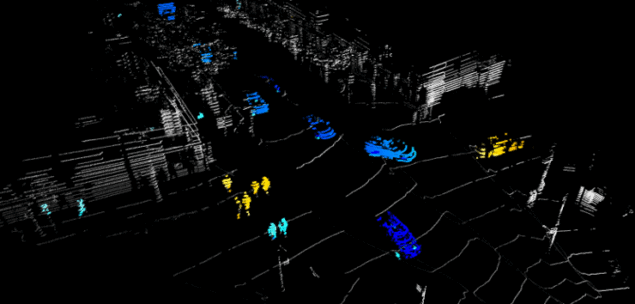
This morning I got a glimpse of what the future might look like for cars that can drive themselves. Randy Reibel and Stephen Crouch from Blackmore, a US-based start-up that has developed a Doppler lidar system for guiding autonomous vehicles, picked me up in their specially kitted out BMW for a quick demo through the streets of San Francisco.
In the back seat, which was fitted with a screen that showed the readout from the laser-scanning system, I could clearly see the motion of cars, pedestrians and other moving objects – including, at one point, one of San Francisco’s famous trolley buses. Unlike conventional lidar systems – which measure distances using reflected pulses of laser light – Doppler-based systems are able to resolve the velocity of vehicles and pedestrians as well as their precise location.
On the screen, objects moving away from us were displayed in oranges and reds, with the hue depending on their speed, while people and vehicles coming towards us appeared in greens and blues. Buildings and other stationary objects were picked out in white, which makes the coloured moving objects really stand out from their background.
I was struck by the resolution that the system could achieve. Crouch pointed out that different parts of a moving pedestrian are displayed in different colours because their feet move faster than the rest of their body.
Blackmore’s system is one of only a few on the market to exploit frequency modulation to extract velocity information. It beams out light from an infrared laser operating at the telecoms wavelength of 1.55 microns, and then mixes the backscattered signal with a reference laser beam to determine the Doppler frequency shift. This allows the system to calculate the velocity with an accuracy of 0.1 m/s for objects moving at speeds of up to 150 m/s.
This frequency-modulated approach enables coherent detection of the reflected signal, which is crucial for future self-driving vehicles. “Imagine having fleets of autonomous vehicles fitted with lidar systems on the streets of a city like San Francisco,” said Crouch. “Coherent detection is the only way to disambiguate the signals.”
Reibel also pointed out that other chipset-driven industries – including mobile phones, automotive radars and GPS systems – have adopted frequency modulation to deliver interference-free data over long distances while using less power than those that rely on the intensity of the beam. “The reality is that physics ultimately wins,” he said. “More importantly, frequency-modulated Doppler lidar sensors are safer for self-driving applications.”
There’s more work to do, however. Reibel and Crouch are well aware of the need to lower the cost and shrink the size of their system, but they seem confident that they are on track to deliver those crucial improvements – not least because their optics works at telecoms wavelengths and so they can take advantage of an established supply chain. They are also investigating other applications of the technology, such as for airborne vehicles and long-distance haulage, which could potentially be deployed more rapidly.



